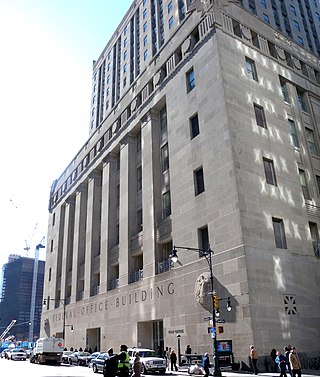History
John Street is named for John Haberdinck, a wealthy Dutch shoemaker who owned the land. [2] Haberdinck bequeathed thirty-five acres of "Shoemakers Field" to the Collegiate Reformed Protestant Dutch Church. [3] The street was historically known as St. John Street; the section between William Street and Pearl Street was also known as Golden Hill, [4] : 58 after a nearby wheat field.
This was the site of the Battle of Golden Hill, a clash between British soldiers and the Sons of Liberty. On January 19, 1770, almost two months before the Boston Massacre, Isaac Sears and others arrested two soldiers posting handbills at the Fly Market at the foot of Maiden Lane. The handbills derided both the Sons of Liberty and their "Liberty poles. Fellow soldiers tried to rescue them while others ran to the barracks on Whitehall Street to sound the alarm. Being outnumbered, the soldiers retreated through the fields, followed by the crowd, until they reached "Golden Hill". Reinforcements from the barracks arrived, as well as additional Sons of Liberty from the ball court at the corner of Broadway and John Street. The mob then rushed the soldiers and a brawl ensued. More soldiers arrived with a group of officers to disperse the crowd before the situation got totally out of hand, and the soldiers were ordered back to barracks. Four individuals received cuts from bayonets, and a sailor was badly hurt. [5]
A widening of John Street at Pearl Street was authorized in 1793, followed by a widening between Pearl Street and Broadway in 1836. [4] : 71
The Romanesque Revival Corbin Building at 13 John Street was later built by Austin Corbin, president of the Long Island Rail Road, on land leased from the Dutch Church. The building, listed on the National Register of Historic Places, [6] became part of the Fulton Center complex in 2012 [7] and became a New York City designated landmark in 2015. [8]

The John Street Theatre at 15 John Street opened in 1767; it was the first permanent playhouse in the city. It was set 60 feet back from the street, with a wooden covered walkway from the pavement to the doors. Inside, it had two tiers of boxes, a pit and a gallery. The dressing rooms and green room were originally located under the stage. [9] It was the New York base of the touring American Company. The theatre was closed temporarily in 1774 by the Continental Association which banned stage plays as extravagant and dissipated, and the company left for Jamaica. When the British occupied the city it was re-opened to boost troop morale. [10] Major John André's scene-painting was much admired. [11] After the Revolution the American Company returned and resumed performances. George Washington visited the theatre in 1789 to see The School for Scandal . [11] The building was demolished in 1798; the site was later occupied by a branch of Brasserie Les Halles.
Between 1803 and 1807 merchant George Codwise Jr., built a wharf along the eastern edge of John Street, adjacent to Burling Slip. It was built of hand-hewn squared pine and hemlock timbers from the Hudson Valley. [12]














